Bacterial Inactivation on Concrete Plates Loaded with Modified TiO2 Photocatalysts under Visible Light Irradiation
Abstract
:1. Introduction
2. Results and Discussion
3. Experimental
3.1. Preparation of the N and/or C-Modified Titania Photocatalysts
3.2. Preparation of Concrete Plates
3.3. Photocatalysts Characterisation
3.4. Determination of the Antimicrobial Properties of Concrete Plates
3.5. Kinetics of the Photocatalytic Disinfection
4. Conclusions
Author Contributions
Funding
Conflicts of Interest
References
- Coffin, M.; Lent, T.; Sabella, S.; Vallette, J.; Walsh, B.; Dickinson, M.; Drake, S.; Guenther, R.; Richter, M.; Stephens, B. Healthy environments: Understanding antimicrobial ingredients in building materials in Healthy Building Network. Available online: https://healthybuilding.net/reports/4-healthy-environments-understanding-antimicrobial-ingredients-in-building-materials (accessed on 20 March 2018).
- Halden, R. On the need and speed of regulating Triclosan and Triclocarban in the United States. Environ. Sci. Technol. 2014, 48, 3603–3611. [Google Scholar] [CrossRef]
- Allen, N.S.; Bygott, C.; Edge, M.; Maltboy, J.; Stratton, J.; Verran, J. Photocatalytic titania based surfaces: Environmental benefits. Polymer Degrad. Stability 2008, 93, 1632–1646. [Google Scholar] [CrossRef]
- Burton, M.; Haselbach, L.; Jobson, B.; Shen, S. Pervious concrete with titanium dioxide as a photocatalyst compound for a greener urban road environment. Construc. Building Mater. 2012, 35, 874–883. [Google Scholar] [CrossRef]
- Guo, S. TiO2-based building materials: Above and beyond traditional applications. Chin. Sci. Bullet. 2009, 54, 1137–1139. [Google Scholar] [CrossRef]
- Nakata, K.; Fujishima, A. TiO2 photocatalysis: Design and applications. J. Photochem. Photobiol. C Photochem. Rev. 2012, 13, 169–189. [Google Scholar] [CrossRef]
- Ramirez, A.M.; Demeestere, K.; De Belie, N.; Mäntylä, T.; Levänen, E. Titanium dioxide coated cementitious materials for air purifying purposes: Preparation, characterization and toluene removal potential. Building Environ. 2010, 45, 832–838. [Google Scholar] [CrossRef]
- Petrella, A.; Mascolo, G.; Murgolo, S.; Petruzzelli, V.; Ranieri, E.; Spasiano, D.; Petruzzelli, D. Photocatalytic oxidation of organic micro-pollutants: Pilot plant investigation and mechanistic aspects of the degradation reaction. Chem. Eng. Commun. 2016, 203, 298–1307. [Google Scholar] [CrossRef]
- Petrella, A.; Spasiano, D.; Cosma, P.; Rizzi, V.; Race, M. Evaluation of the hydraulic and hydrodynamic parameters influencing photo-catalytic degradation of bio-persistent pollutants in a pilot plant. Chem. Eng. Commun. 2019. In Print. [Google Scholar] [CrossRef]
- Agrios, A.G.; Pichat, P. State of the art and perspectives on materials and applications of photocatalysis over TiO2. J. Appl. Electrochem. 2005, 58, 655–663. [Google Scholar] [CrossRef]
- Hüsken, G.; Hunger, M.; Brouwers, H.J.H. Experimental study of photocatalytic concrete products for air purification. Building Environ. 2009, 44, 2463–2474. [Google Scholar] [CrossRef]
- Zhang, J.; Wu, J.; Xing, M.; Leghari, S.A.K.; Sajjad, S. Development of modified N doped TiO2 photocatalyst with metals, nonmetals and metal oxides. Energy Environ. Sci. 2010, 3, 715–726. [Google Scholar] [CrossRef]
- Mo, J.; Zhang, Y.; Xu, Q.; Lamson, J.J.; Zhao, R. Photocatalytic purification of volatile organic compounds in indoor air: A literature review. Atmos. Environ. 2009, 43, 2229–2246. [Google Scholar] [CrossRef]
- Janus, M.; Kusiak, E.; Morawski, A.W. Carbon-modified TiO2 photocatalyst with enhanced absorptivity for dyes from water. Cataly. Lett. 2009, 131, 506–511. [Google Scholar] [CrossRef]
- Tryba, B.; Tygielska, M.; Colbeau-Justin, C.; Kusiak-Nejman, E.; Kapica-Kozar, J.; Wróbel, R.J.; Żołnierkiewicz, G.; Guskos, N. Influence of pH of sol-gel solution phase composition and photocatalytic activity of TiO2 under UV and visible light’. Mater. Res. Bullet. 2016, 84, 152–161. [Google Scholar] [CrossRef]
- Liochev, S.I. Reactive oxygen species and the free radical theory of ageing. Free Rad. Biol. Med. 2013, 60, 1–4. [Google Scholar] [CrossRef] [PubMed]
- Markov, S.L.; Vidaković, A.W. Testing methods for antimicrobial activity of TiO2 photocatalyst. Apteff 2014, 15, 141–152. [Google Scholar] [CrossRef]
- Muhammad, M.H.; Uba, F.; Madinat, R.; Muhd, M.; Sulaiman, M.A.; Zubair, M.S. Isolation and identification of airborne bacteria from Federal University Dutse Lecture Room. Int. J. Sci. Technol. Res. 2017, 16–19. [Google Scholar]
- Chahal, N.; Siddique, R.; Rajor, A. Influence of bacteria on the compressive strength, water absorption and rapid chloride permeability of fly ash concrete. Construct. Building Mater. 2012, 28, 351–356. [Google Scholar] [CrossRef]
- Guo, M.Z.; Ling, T.C.; Poon, C.S. TiO2-based self-compacting glass mortar: Comparison of photocatalytic nitrogen oxide removal and bacteria inactivation. Building Environ. 2012, 53, 1–6. [Google Scholar] [CrossRef]
- Barbieriková, Z.; Pližingrová, E.; Motlochová, M.; Bezdička, P.; Boháček, J.; Dvoranová, D.; Mazúr, M.; Kupčík, J.; Jirkovský, J.; Šubrt, J.; et al. N-Doped titanium dioxide nanosheets: Preparation, characterization and UV/visible-light activity. Appl. Cataly. B 2018, 232, 397–408. [Google Scholar] [CrossRef]
- Pan, X.; Liang, X.; Yao, L.; Wang, X.; Jing, Y.; Ma, J.; Fei, Y.; Chen, L.; Mi, L. Study of the Photodynamic Activity of N-Doped TiO2 Nanoparticles Conjugated with Aluminum Phthalocyanine. Nanomaterials 2017, 7, 338. [Google Scholar] [CrossRef] [PubMed]
- Janus, M.; Zatorska, J.; Czyżewski, A.; Bubacz, K.; Kusiak-Nejman, E.; Morawski, A.W. Self-cleaning properties of cement plates loaded with N,C-modified TiO2 photocatalysts. Appl. Surface Sci. 2015, 330, 200–206. [Google Scholar] [CrossRef]
- Mathpal, M.C.; Tripathi, A.K.; Singh, M.K.; Gairola, S.P.; Pandey, S.N.; Agarwal, A. Effect of annealing temperature on Raman spectra of TiO2 nanoparticles. Chem. Phys. Lett. 2013, 455, 182–186. [Google Scholar] [CrossRef]
- Sugapriya, S.; Sriram, R.; Lakshmi, S. Effect of annealing on TiO2 nanoparticles. Optik 2013, 124, 4971–4975. [Google Scholar] [CrossRef]
- Bertron, A.; Coutand, M.; Roques, C.; Verdier, T. Antibacterial activity of TiO2 photocatalyst alone or in coatings on E. coli: The influence of methodological aspects. Coatings 2014, 4, 670–686. [Google Scholar] [CrossRef]
- Huang, Z.; Maness, P.H.; Blake, D.M.; Wolfrum, E.J.; Smolicki, S.L.; Jacoby, W.A. Bactericidal mode of titanium dioxide photocatalysis. J. Photochem. Photobiol. A Chem. 2000, 130, 163–170. [Google Scholar] [CrossRef]
- Piegot-Rémy, S.; Simonet, F.; Errazuriz-Carda, E.; Lazzaroni, J.C.; Atlan, D.; Guillard, C. Photocatalysis and disinfection of water: Identification of potential bacterial target. Appl. Cataly. B Environ. 2011, 104, 390–398. [Google Scholar] [CrossRef]
- Zuo, X.; Hu, J.; Chen, M.D. The role and fate of inorganic nitrogen species during UVA/TiO2 disinfection. Water Res. 2015, 80, 12–19. [Google Scholar] [CrossRef]
- Benabbou, A.K.; Derriche, Z.; Felix, C.; Lejeune, P.; Guillard, C. Photocatalytic inactivation of Escherichia coli Effect of concentration of TiO2 and microorganism, nature, and intensity of UV irradiation. Appl. Cataly. B Environ. 2007, 76, 257–263. [Google Scholar] [CrossRef]
- Marugán, J.; Grieken, R.V.; Sordo, C.; Cruz, C. Kinetics of the photocatalytic disin-fection of Escherichia coli suspensions. Appl. Cataly. B Environ. 2008, 82, 27–36. [Google Scholar] [CrossRef]
- Sunada, K.; Watanabe, T.; Hashimoto, K. Studies on photokilling of bacteria on TiO2 thin film. J. Photochem. Photobiol. A 2003, 156, 227–233. [Google Scholar] [CrossRef]
- Janus, M.; Zatorska, J.; Zając, K.; Kusiak-Nejman, E.; Czyżewski, A.; Morawski, A.W. Study of nitric oxide degradation properties of photoactive concrete containing nitrogen and/or carbon co-modified titanium dioxide–preliminary findings. Micro Nano Lett. 2016, 11, 231–235. [Google Scholar] [CrossRef]
- Hom, L.W. Kinetics of chlorine disinfection in an ecosystem. J. Sanitary Eng. Division 1972, 98, 183–194. [Google Scholar]
Sample Availability: Not available |
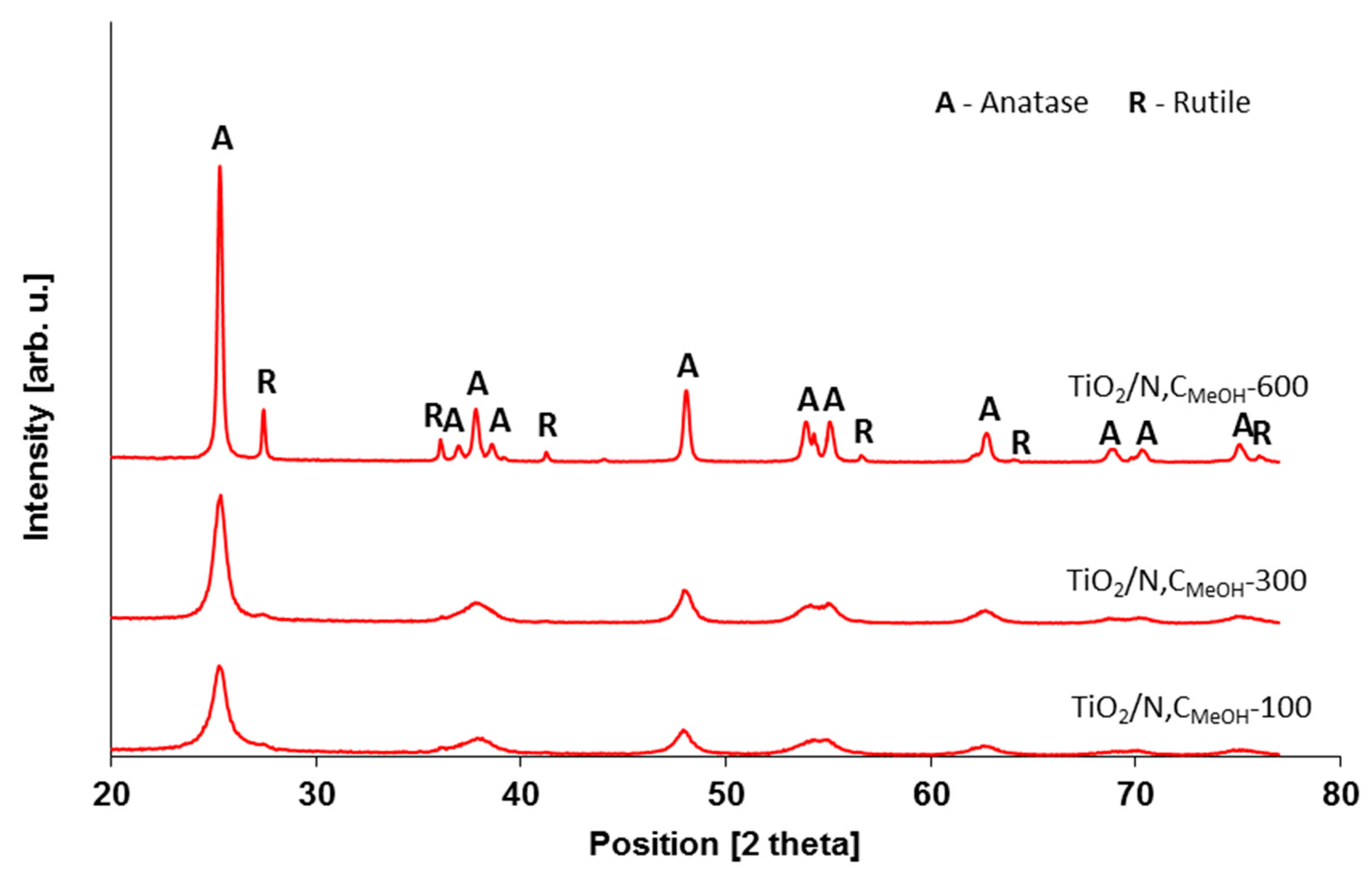
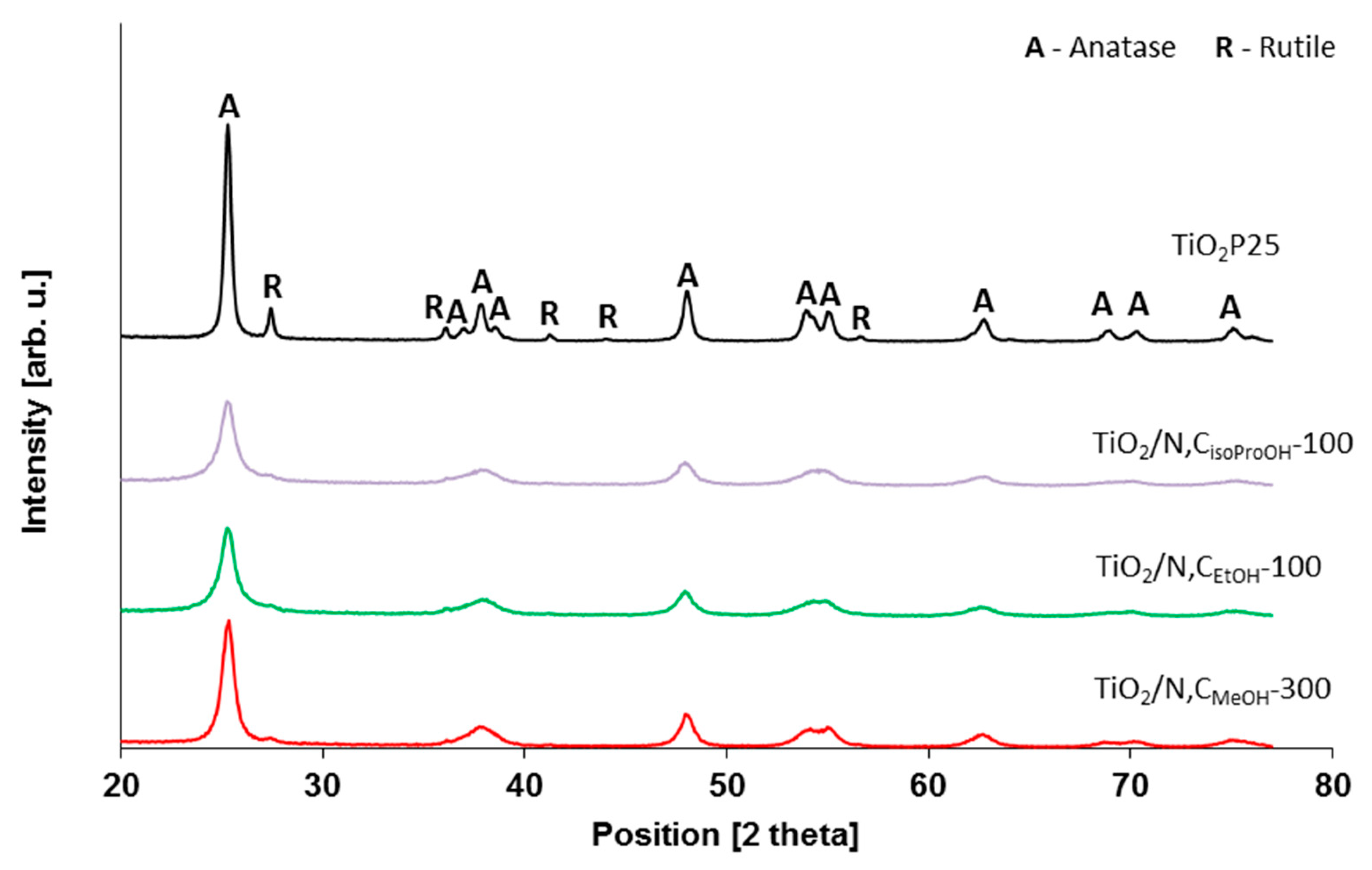
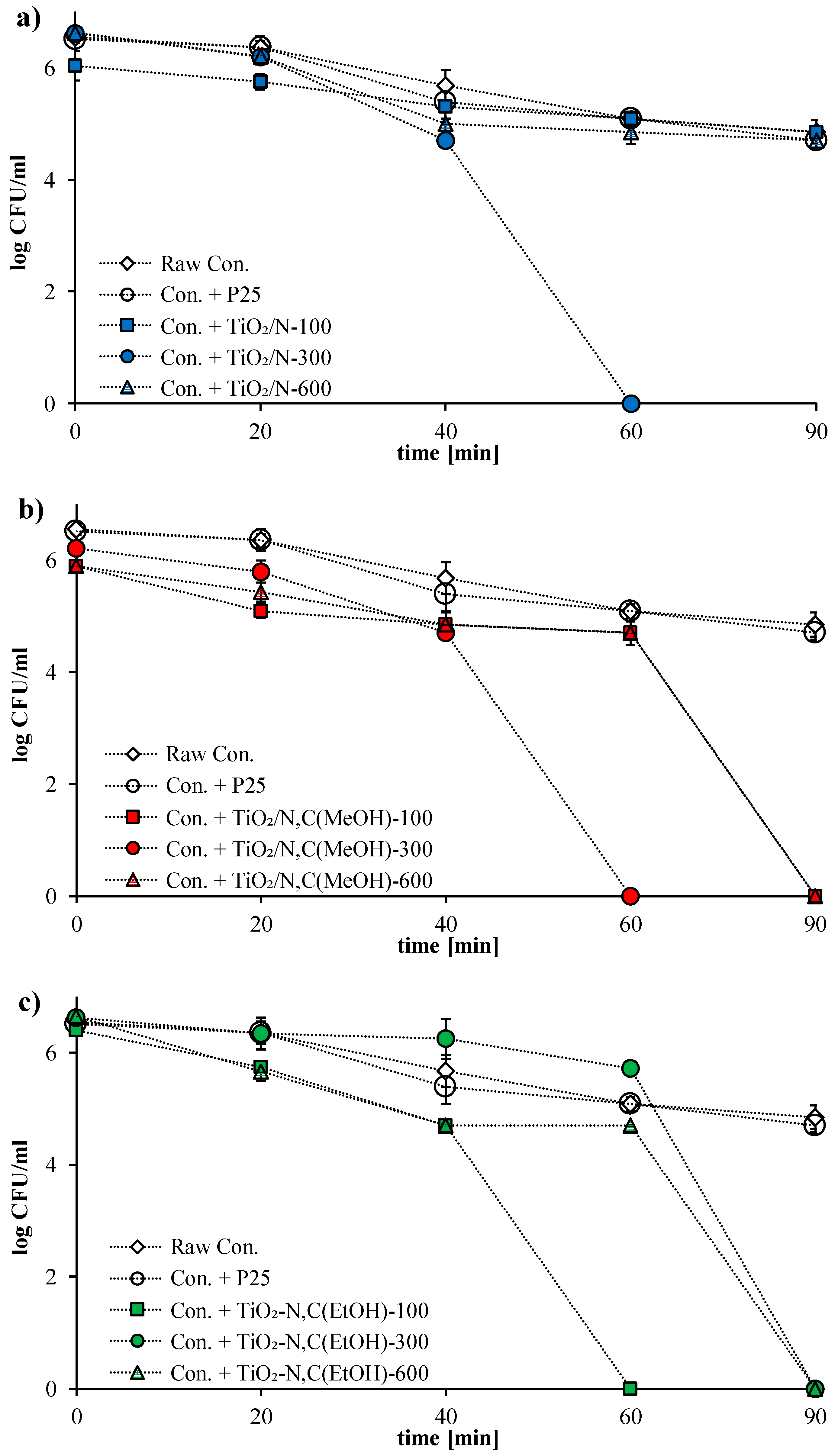
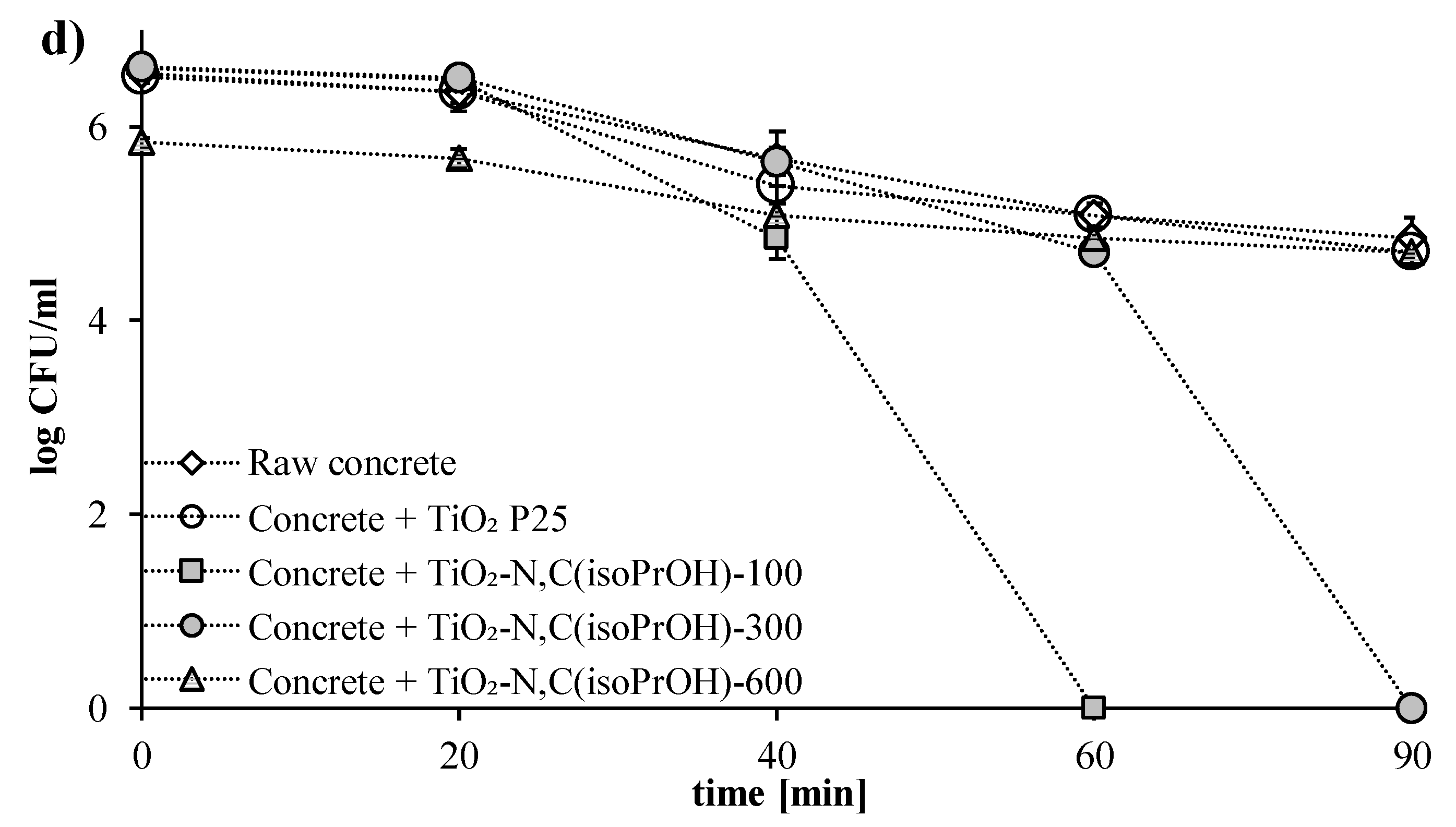


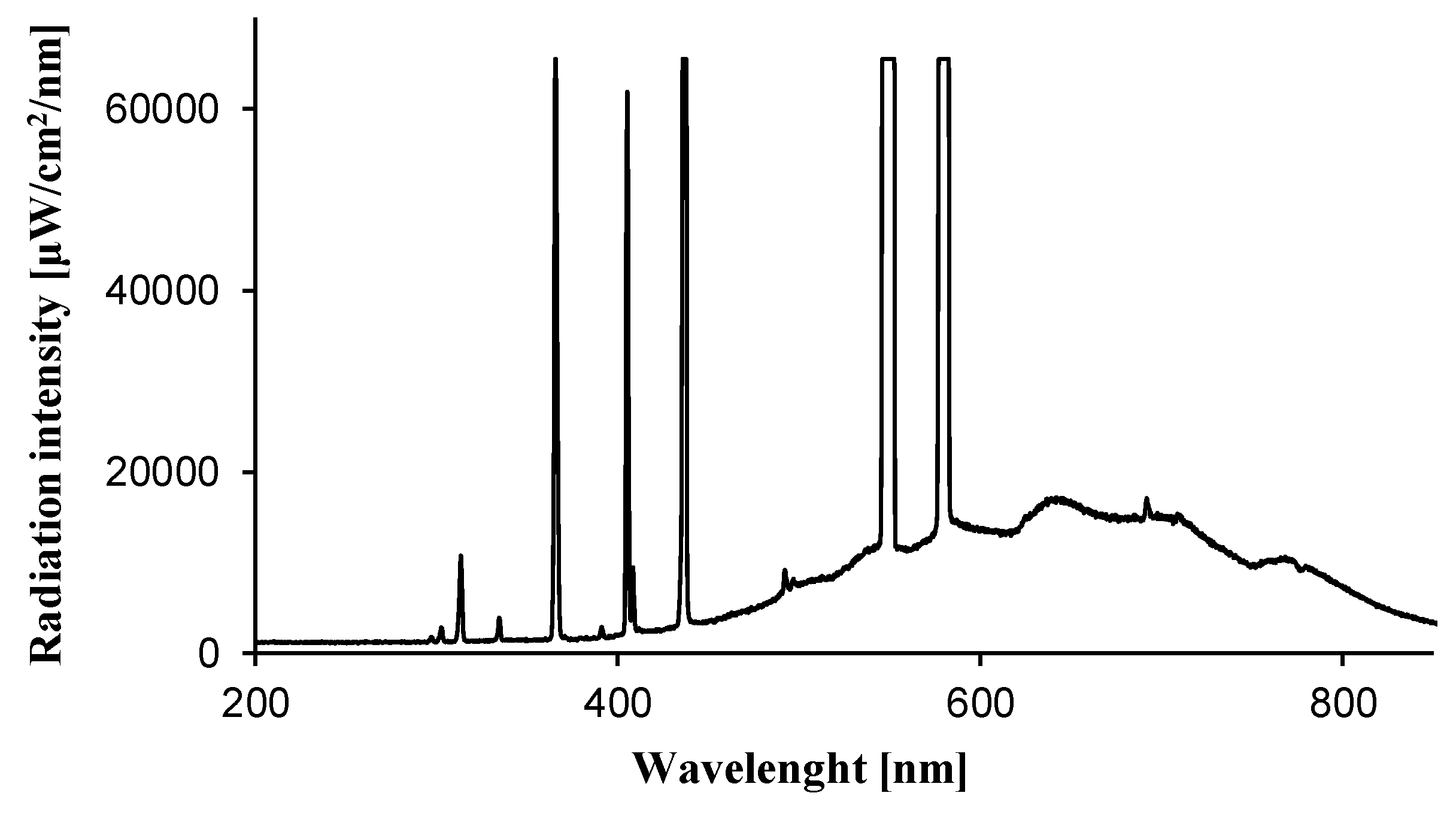
| Sample Code | SBET [m2/g] | Crystallite Size * [nm] | Crystallite Contribution [%] | Nitrogen Content [wt.%] | Carbon Content [wt.%] | |
|---|---|---|---|---|---|---|
| Anatase | Anatase | Rutile | ||||
| TiO2 P25 | 55 | 21 | 80 | 20 | - | - |
| TiO2/N-100 | 259 | 10 | 97 | 3 | 0.57 | - |
| TiO2/N-300 | 158 | 13 | 95 | 5 | 0.31 | - |
| TiO2/N-600 | 34 | 28 | 87 | 13 | 0.05 | - |
| TiO2/N,CMeOH-100 | 277 | 10 | 98 | 2 | 1.11 | 1.6 |
| TiO2/N,CMeOH-300 | 161 | 12 | 98 | 2 | 1.05 | 0.7 |
| TiO2/N,CMeOH-600 | 29 | 34 | 83 | 17 | 1.18 | 0.06 |
| TiO2/N,CEtOH-100 | 269 | 10 | 97 | 3 | 0.93 | 1.02 |
| TiO2/N,CEtOH-300 | 168 | 13 | 97 | 3 | 0.77 | 0.87 |
| TiO2/N,CEtOH-600 | 23 | 33 | 88 | 12 | 0.39 | 0.04 |
| TiO2/N,CisoPrOH-100 | 265 | 10 | 98 | 2 | 1.17 | 0.97 |
| TiO2/N,CisoPrOH-300 | 166 | 13 | 97 | 3 | 0.32 | 0.26 |
| TiO2/N,CisoPrOH-600 | 30 | 33 | 85 | 15 | 0.12 | 0.05 |
| Samples | Time [min] | ||||||
|---|---|---|---|---|---|---|---|
| 20 | 40 | 60 | 90 | ||||
| Samples Code | Calcination Temperature [°C] | Bacteria Removal Rate [%] | |||||
| Raw concrete | - | 16.1 | 13.8 | 19.8 | 31.6 | ||
| Concrete + TiO2 P25 | - | 8.5 | 9.5 | 13.8 | 17.7 | ||
| Concrete + TiO2 | N | - | 100 | 2.7 | 15.4 | 24.9 | 32.3 |
| - | 300 | 10.3 | 18.6 | 47.5 | 57.1 | ||
| - | 600 | 0.3 | 39.9 | 43.1 | 45.3 | ||
| CMeOH | 100 | 9.6 | 34.0 | 36.9 | 51.9 | ||
| 300 | 13.4 | 40.3 | 47.3 | 52.1 | |||
| 600 | 2.1 | 10.5 | 31.1 | 44.5 | |||
| CEtOH | 100 | 12.6 | 39.2 | 42.6 | 52.2 | ||
| 300 | 11.4 | 45.4 | 100 | 100 | |||
| 600 | 4.3 | 7.7 | 29.4 | 100 | |||
| CisoPrOH | 100 | 6.3 | 33.5 | 34.7 | 40.5 | ||
| 300 | 11.7 | 32.8 | 38.0 | 41.0 | |||
| 600 | 1.4 | 12.5 | 34.7 | 43.1 | |||
| Samples | Time [min] | ||||||
|---|---|---|---|---|---|---|---|
| 20 | 40 | 60 | 90 | ||||
| Samples Code | Calcination Temperature [°C] | Bacteria Removal Rate [%] | |||||
| Raw concrete | - | 1.6 | 12.6 | 18.6 | 41.7 | ||
| Concrete + TiO2 P25 | - | 1.9 | 7.4 | 22.7 | 56.3 | ||
| Concrete + TiO2 | N | - | 100 | 8.8 | 32.8 | 44.9 | 53.2 |
| - | 300 | 6.3 | 42.2 | 100 | 100 | ||
| - | 600 | 2.3 | 38.1 | 46.4 | 61.0 | ||
| CMeOH | 100 | 11.8 | 21.1 | 46.2 | 100 | ||
| 300 | 3.9 | 50.8 | 100 | 100 | |||
| 600 | 5.4 | 36.2 | 52.8 | 100 | |||
| CEtOH | 100 | 11.4 | 45.4 | 100 | 100 | ||
| 300 | 6.3 | 18.3 | 35.9 | 100 | |||
| 600 | 21.0 | 53.5 | 53.3 | 100 | |||
| CisoPrOH | 100 | 9.8 | 34.8 | 100 | 100 | ||
| 300 | 3.6 | 24.4 | 49.9 | 100 | |||
| 600 | 2.9 | 32.1 | 34.5 | 56.9 | |||
| R2 Value | ||||
|---|---|---|---|---|
| Sample Code | Chick-Watson | Modified Chick-Watson | Hom | Modified Hom |
| Raw concrete | 0.951 | 0.950 | 0.995 | 0.994 |
| Concrete + TiO2 P25 | 0.963 | 0.962 | 0.964 | 0.995 |
| Concrete + TiO2/N-100 | 0.777 | 0.918 | 0.884 | 0.993 |
| Concrete + TiO2/N-300 | 0.885 | 0.880 | 0.996 | 0.999 |
| Concrete + TiO2/N-600 | 0.821 | 0.917 | 0.821 | 0.985 |
| Concrete + TiO2/N,C(MeOH)-100 | 0.817 | 0.962 | 0.842 | 0.984 |
| Concrete + TiO2/N,C(MeOH)-300 | 0.916 | 0.915 | 0.997 | 0.999 |
| Concrete + TiO2/N,C(MeOH)-600 | 0.990 | 0.998 | 0.997 | 0.999 |
| Concrete + TiO2-N,C(EtOH)-100 | 0.980 | 0.978 | 0.998 | 0.999 |
| Concrete + TiO2-N,C(EtOH)-300 | 0.884 | 0.883 | 0.934 | 0.998 |
| Concrete + TiO2-N,C(EtOH)-600 | 0.870 | 0.968 | 0.952 | 0.997 |
| Concrete + TiO2-N,C(isoPrOH)-100 | 0.757 | 0.766 | 0.998 | 0.999 |
| Concrete + TiO2-N,C(isoPrOH)-300 | 0.864 | 0.863 | 0.995 | 0.999 |
| Concrete + TiO2-N,C(isoPrOH)-600 | 0.889 | 0.921 | 0.909 | 0.961 |
| Kinetic Constants | |||||||||
|---|---|---|---|---|---|---|---|---|---|
| Kinetic Model | Chick-Watson | Modified Chick-Watson | Hom | Modified Hom | |||||
| Sample Code | K | k1 | k2 | k | h | k1 | k2 | k3 | |
| Raw concrete | 0.0193 | 17.032 | 0.0011 | 0.0121 | 1.1041 | 1.8401 | 0.0471 | 5.6751 | |
| Concrete + TiO2 P25 | 0.2073 | 25.048 | 0.0008 | 0.0156 | 1.0051 | 1.9732 | 0.0422 | 4.0911 | |
| Concrete + TiO2/N-100 | 0.0161 | 1.426 | 0.0231 | 0.0957 | 0.6789 | 1.1380 | 0.1457 | 23.271 | |
| Concrete + TiO2/N-300 | 0.0425 | 178.97 | 0.0002 | 0.0006 | 2.1893 | 3.2827 | 0.0608 | 5.8513 | |
| Concrete + TiO2/N-600 | 0.0252 | 2.442 | 0.0188 | 0.1112 | 0.6471 | 1.8033 | 0.1238 | 16.677 | |
| Concrete + TiO2/N,C(MeOH)-100 | 0.0219 | 1.191 | 0.0472 | 0.2377 | 0.3834 | 2.8938 | 0.0016 | 0.3945 | |
| Concrete + TiO2/N,C(MeOH)-300 | 0.0342 | 157.65 | 0.0002 | 0.0012 | 1.9572 | 3.267- | 0.0418 | 3.7096 | |
| Concrete + TiO2/N,C(MeOH)-600 | 0.0297 | 2.936 | 0.0086 | 0.0369 | 0.8511 | 1.6732 | 0.0268 | 1.4654 | |
| Concrete + TiO2-N,C(EtOH)-100 | 0.0406 | 107.10 | 0.0003 | 0.0113 | 1.3636 | 2.2023 | 0.0720 | 4.4654 | |
| Concrete + TiO2-N,C(EtOH)-300 | 0.0139 | 55.863 | 0.0002 | 0.0009 | 1.6813 | 7.9963 | 0.0012 | 1.6725 | |
| Concrete + TiO2-N,C(EtOH)-600 | 0.0383 | 2.449 | 0.0396 | 0.2102 | 0.5617 | 1.9543 | 0.4301 | 33.760 | |
| Concrete + TiO2-N,C(isoPrOH)-100 | 0.0392 | 212.19 | 0.0018 | 0.0001 | 3.9712 | 9.7661 | 0.0408 | 7.5177 | |
| Concrete + TiO2-N,C(isoPrOH)-300 | 0.0271 | 129.76 | 0.0002 | 0.0003 | 2.1056 | 3.6687 | 0.0360 | 5.3031 | |
| Concrete + TiO2-N,C(isoPrOH)-600 | 0.0139 | 1.869 | 0.0107 | 0.0370 | 0.7920 | 1.0558 | 0.0812 | 7.7489 | |
© 2019 by the authors. Licensee MDPI, Basel, Switzerland. This article is an open access article distributed under the terms and conditions of the Creative Commons Attribution (CC BY) license (http://creativecommons.org/licenses/by/4.0/).
Share and Cite
Janus, M.; Kusiak-Nejman, E.; Rokicka-Konieczna, P.; Markowska-Szczupak, A.; Zając, K.; Morawski, A.W. Bacterial Inactivation on Concrete Plates Loaded with Modified TiO2 Photocatalysts under Visible Light Irradiation. Molecules 2019, 24, 3026. https://doi.org/10.3390/molecules24173026
Janus M, Kusiak-Nejman E, Rokicka-Konieczna P, Markowska-Szczupak A, Zając K, Morawski AW. Bacterial Inactivation on Concrete Plates Loaded with Modified TiO2 Photocatalysts under Visible Light Irradiation. Molecules. 2019; 24(17):3026. https://doi.org/10.3390/molecules24173026
Chicago/Turabian StyleJanus, Magdalena, Ewelina Kusiak-Nejman, Paulina Rokicka-Konieczna, Agata Markowska-Szczupak, Kamila Zając, and Antoni W. Morawski. 2019. "Bacterial Inactivation on Concrete Plates Loaded with Modified TiO2 Photocatalysts under Visible Light Irradiation" Molecules 24, no. 17: 3026. https://doi.org/10.3390/molecules24173026
APA StyleJanus, M., Kusiak-Nejman, E., Rokicka-Konieczna, P., Markowska-Szczupak, A., Zając, K., & Morawski, A. W. (2019). Bacterial Inactivation on Concrete Plates Loaded with Modified TiO2 Photocatalysts under Visible Light Irradiation. Molecules, 24(17), 3026. https://doi.org/10.3390/molecules24173026










